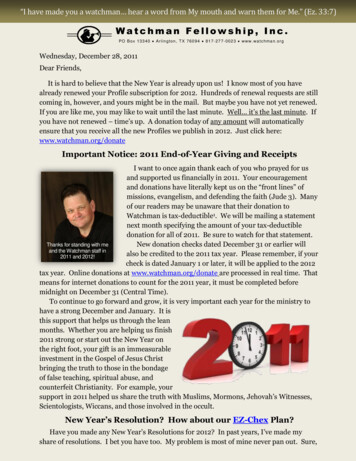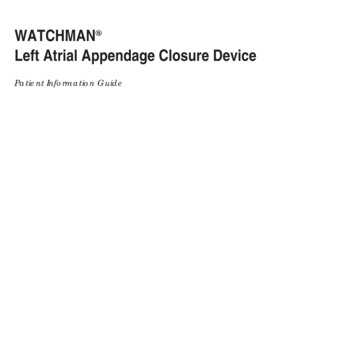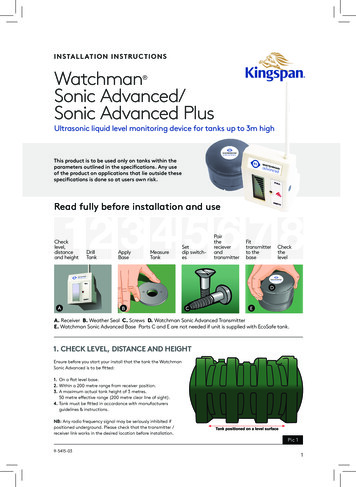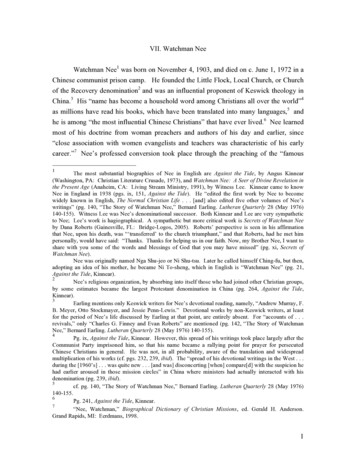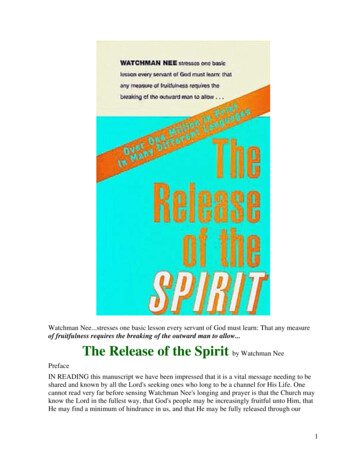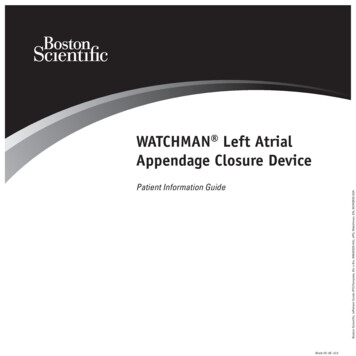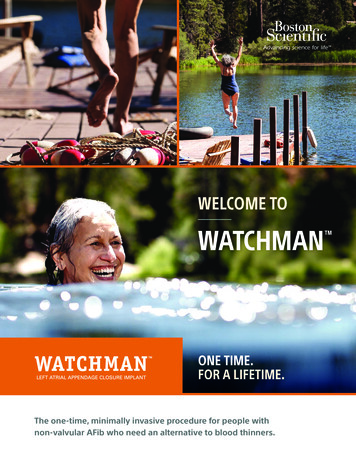
Transcription
WELCOME TOWATCHMAN ONE TIME.FOR A LIFETIME.The one-time, minimally invasive procedure for people withnon-valvular AFib who need an alternative to blood thinners.
MORE THAN 200,000 PEOPLEHAVE LEFT BLOOD THINNERS BEHINDWITH THE WATCHMAN IMPLANT.Non-valvular AFib can mean a lifetime of blood thinners.It can also mean a lifetime of worry about bleeds from falls,other medical issues, or an unexpected surgery.When I was on blood thinners,it was always a different life.WATCHMAN was a lifesaver. Itput me back to being who I was.—CLIFF, 68The WATCHMAN Implant procedure is a trusted alternativethat permanently reduces both stroke risk and bleedingworry. With almost 20 years of clinical and real-worldexperience—including 10 clinical trials—it is proven to besafe and effective.Here’s what you’ll find inside this brochure.STROKE RISK REDUCTION OPTIONSWHAT THE WATCHMAN IMPLANT IS AND HOW IT WORKSBEFORE, DURING AND AFTER YOUR PROCEDURELIVING LIFE WITH THE WATCHMAN IMPLANTHOW TO GET IN TOUCH WITH USRead on to learn more about the WATCHMAN Implant.3
STROKE RISK REDUCTION OPTIONSTHE GOAL: REDUCING YOUR STROKE RISK.BLOOD THINNERS ARE ONE WAY.Blood thinners reduce the risk of clots that could lead to a stroke.The blood thinner warfarin (also known as Coumadin ) has been around for more than 60 years.There are also several newer blood thinners available now, including Eliquis (apixaban), Pradaxa (dabigatran), Xarelto (rivaroxaban), and Savaysa (edoxaban).Blood thinners are effective, but can come with challengesand potential bleeding worries.Major and minor bleedingrisks from other medicalconditions or fallsComplications duringsurgeryLifestyle activities thatcarry a risk of bleedingHigh ongoing costDifficulty with once ortwice-daily pill dosingIf taking warfarin, regularmonitoring and food/druginteractionsTHE WATCHMAN IMPLANT IS ANALTERNATIVE TO BLOOD THINNERS.It’s a one time, minimally-invasive procedurethat permanently reduces stroke risk without theworries that come with a lifetime of blood thinners.For some people, that means an extra measure of safety if theyhave bleeding due to certain medical conditions, such as an ulcer.For others, it means peace of mind should they need surgery. Amore active lifestyle is also less risky, including travel that’s notnear medical help.4I was restricted on bloodthinners and now I canjust go to where I want to goand do what I want to do.—MICHAEL, 79Is the WATCHMAN Implantright for you?The WATCHMAN Implant is indicated for peoplewho have AFib not caused by a heart valveproblem (also known as non-valvular AFib), havebeen recommended for blood thinning medicinesby their doctor but need an alternative.The WATCHMAN Implant maybe right for you if:While some people may be ablestop blood thinners immediatelyafter the procedure, in a clinical trial96% of peoplewere able to discontinue their bloodthinner 45 days after theWATCHMAN Implant.1You have a lifestyle, occupation, or health concern that puts youat risk for serious bleedingYou’ve had serious bleedingwhile taking blood thinnersYou have difficulty takingblood thinners as prescribedby your doctorTalk to your cardiologist about the benefitsand risks. Together, you’ll decide if theWATCHMAN Implant is right for you.1. PINNACLE FLX 12-month primary safety and efficacy endpointresults, Doshi, SK. presented at HRS 2020 Science. 2. ArmstrongS, Amorosi SL, Patel P, Erickson GC, Stein K. Medicare beneficiaryout-of-pocket spending for stroke prevention in non-valvular atrialfibrillation: a budget analysis. Value Health (ISPOR). 2015;18:A1-A307(A40,PMD13). 3015(15)00296-X/pdf. Accessed March 28,2019.What about cost?While blood thinners must be taken every dayfor life and represent an ongoing cost, theWATCHMAN Implant is a one-time procedureand one-time cost. This means you can saveyou money over time. For example, the totalout-of-pocket spending for the WATCHMANImplant is lower than warfarin by year 2 andhalf the cost by year 5.2Medicare covers the WATCHMAN Implantfor people who meet certain coveragecriteria and an increasing number of otherinsurers do too. Insurance coverage can varysignificantly from one plan to another. Besure to contact your insurance carrier for anyspecific questions.5
WHAT THE WATCHMAN IMPLANT IS AND HOW IT WORKSTAKING A CLOSER LOOKAT THE WATCHMAN IMPLANT.With WATCHMAN, I can forgetabout the concern of a stroke.I can forget about the concernof side effects from drugs and justtry to live a happy, healthy life.What is the WATCHMAN Implant?The WATCHMAN Implant is a small, flexibleimplant about the size of a quarter. It is madefrom very light, compact materials commonlyused in many other medical implants.It is placed into your heart during a minimallyinvasive procedure and never needs tobe replaced.—AJ, 68 1 INCHIs the WATCHMAN Implant safe?How exactly does it work?To understand how the WATCHMAN Implantworks, it helps to understand the connectionbetween AFib and stroke.LEFT ATRIALAPPENDAGE(LAA)Atrial fibrillation, or AFib, affects your heart’sability to pump blood normally. This can causeblood to pool in an area called the left atrialappendage, or LAA. There, blood cells can sticktogether and form a clot. When a blood clotescapes from the LAA and travels to another partof the body, it can cut off the blood supply to thebrain, causing a stroke.1,2 On average, a personwith AFib is 5 times more likely to suffer a strokethan someone with a regular heartbeat.3In people with AFib not caused by a heart valveproblem, more than 90% of stroke-causing clotsthat come from the heart are formed in the LAA.1That’s why closing off this part of the heart isan effective way to reduce stroke risk.The WATCHMAN Implant fits rightinto your LAA. It’s designed topermanently close it off and keepthose blood clots from escaping.6200,000 20 YEARSOver 200,000 people have alreadyreceived the WATCHMAN Implant. Withalmost 20 years of clinical and real-worldexperience — including 10 clinical trials —WATCHMAN has a proven safety record.Advanced, Heart-Friendly DesignScience always looks for ways to make effective treatments evenbetter. The WATCHMAN Implant is no exception. The WATCHMANFLX Implant design is an advancement that enables the implant tofit a greater number of patients, giving more people than ever asafe, effective alternative to blood thinners should they need one.Learn more about the WATCHMAN Implantand how it works at watchman.com/video1. Blackshear JL, Odell JA. Appendage obliteration to reduce stroke in cardiac surgical patients with atrial fibrillation. Ann ThoracSurg. 1996;61:755-759. 2. National Stroke Association. Making the Afib-Stroke Connection. es/Afib-Connection%20for%20hcp.pdf. Published 2012. Accessed September 1, 2016. 3. National StrokeAssociation. Making the Afib-Stroke Connection. es/Afib- Connection%20for%20hcp.pdf. Published 2012. Accessed September 1, 2016.7
BEFORE, DURING AND AFTER YOUR PROCEDURETHE WATCHMAN IMPLANT PROCEDURE:WHAT TO EXPECT.Post-procedure, I was in the hospital for 24hours with great food and a wonderful staff,and then home relaxing for the next weekwith a bit of limitation on strenuous activity.The decision to get the WATCHMAN Implant is shared between you andyour doctor. You’ll talk about what’s important to you, your goals, and theprocedure’s risks and benefits. Together, you’ll decide whether the WATCHMANImplant is the right choice for you. If so, here is what comes next.—SEAN, 84BEFOREDURINGAFTERGETTING READY.PROCEDURE DAY.YOUR FIRST YEAR WITH YOUR WATCHMAN IMPLANT.Get insurance approval. The WATCHMANImplant is covered for eligible Medicare patientsand does not require advance approval. If youhave commercial insurance, you may need priorauthorization from your plan. Your doctor’soffice may be able to assist.STEP 1Choose a medical center. You and your doctorwill decide on a center. You can view options atwatchman.com/centers, and your doctor willprovide a referral. Typically, the medical centerwill call you to schedule a consultation, or yourdoctor’s office may schedule it for you.STEP 2Have an exam and heart scan. In addition toa physical, you may have a special test called aTEE (transesophogeal echocardiogram) whichtakes pictures of your heart so the doctor cansee your LAA and to make sure you don’t havean existing blood clot.Set the date for your WATCHMAN Implantprocedure. Your doctor and implant team will tellyou how to prepare. Make sure you understandall the instructions, including what medicationsyou should and should not take, and ask anyquestions you have.To begin the procedure, yourdoctor makes a small cut inyour upper leg and inserts anarrow tube.Your doctor guides theWATCHMAN Implant throughthe tube, into your left atrialappendage (LAA).STEP 3The procedure is typically doneunder general anesthesiaand takes about 30 minutes.People who get the WATCHMANImplant generally stay in thehospital for a day or less.Your doctor will prescribe you a medicationregimen they believe is right for you. Typically,this will be one of two options:OPTION AYour doctor will prescribe anti-platelet medicinecalled clopidogrel (also known as Plavix)and aspirin for 6 months. At your 6-monthappointment, your doctor may stop the antiplatelet medicine and you’ll continue to takeaspirin on an ongoing basis.OPTION BYou may be prescribed a short-term bloodthinner (anticoagulant), typically for 45 days.Then your doctor may stop blood thinners andput you on an anti-platelet and aspirin until6 months post-procedure. After that, you’llcontinue to take aspirin on an ongoing basis.These medications are taken until your left atrialappendage is completely closed off. Whicheveroption they choose, it’s important that youdiscuss your medications with your doctor anddo not change or modify your medications ordosages unless prescribed by your doctor.Most people can return to work within a fewdays. Gradually add activities to get back to yournormal routine. Check with your doctor beforeresuming exercise or anything strenuous.You may have follow-up appoints after yourprocedure to have an imaging test to checkon the implant and make sure your left atrialappendage (LAA) is sealed. Discuss schedulingyour follow-up appointments with your doctor.OPTION A: Anti-plateletsIMPLANTAnti-platelet Aspirin6 MonthsSTEP 4After the procedure, your ownheart tissue will grow over theWATCHMAN Implant to form abarrier against blood clots.AspirinOngoingMEDICATION OPTIONS AFTER YOUR PROCEDUREOPTION B: Short-term blood thinnersOPTION A: Anti-plateletsIMPLANTAnti-platelet Aspirin6 MonthsAspirinOngoingIMPLANTBloodThinner45 DaysAnti-platelet Aspirin6 MonthsAspirinOngoingOPTION B: Short-term blood thinnersIMPLANT8BloodThinner45 DaysAnti-platelet Aspirin6 MonthsAspirinOngoing9
LIVING LIFE WITH THE WATCHMAN IMPLANTWATCHMAN IMPLANT.IT’S ONE TIME. FOR A LIFETIME.WANT TO KNOW MORE?LET US ANSWER YOUR QUESTIONS.The WATCHMAN Implant may provide a lifetime of stroke risk reduction thatlets you leave blood thinner worries behind.After the WATCHMAN Implant procedure, life is a lot less restricted. Without the constant concern ofblood thinner bleeds following you everywhere, you’re freer to be active, to travel, to go where youwant to go and do what you want to do. The WATCHMAN Implant protects you in all these situations.Out in the world with the WATCHMAN Implant.TRAVELYour WATCHMANImplant will not set offmetal detectors, so youcan go through securityscreenings without worry.MEDICAL ANDDENTAL PROCEDURESAlways tell the doctor ordentist that you have aWATCHMAN Implant so heor she can work with yourcardiologist to determinethe best way to providetreatment—especially Ifthe procedure requiresyou to stop taking yourmedications as prescribed.MRIIf you need an MRI(magnetic resonanceimaging), it’s importantto show the doctor andMRI technologist yourWATCHMAN Implant Card.The WATCHMAN Implantis “MRI conditional,” whichmeans you can safelyhave an MRI when yourtechnologist takescertain precautions.TALK TO ANEDUCATION SPECIALIST.TALK TO A PATIENTAMBASSADOR.GET A CUSTOMIZEDDISCUSSION GUIDE.Our trained professionalshave healthcare experience.They’re here to answer yourWATCHMAN Implant questionsand help you get ready to talkto your cardiologist.Our ambassadors havethe WATCHMAN Implantthemselves and havevolunteered to share theirexperiences. We hand-picksomeone to talk with youbased on your questions.Ready to talk to yourdoctor about the WATCHMANImplant? We make it easy.Answer a few questions andget a discussion guide that’scustomized to your needs.Call 1-855-802-3909Mon-Fri, 8 am to 5 pm CTTo learn more, call1-844-355-9114Download it ateligibility.watchman.comI didn’t have any problems getting the [WATCHMAN]procedure and I feel so much better since I had it. It makesme feel good that I can get up and go and not worry.—CAMILLE, 89What is a WATCHMAN Implant Cardand why do I need it?You’ll get a WATCHMAN Implant Card from the medical centerthat performs your procedure. This very important card letsmedical personnel know that you have the WATCHMANImplant. Remember to carry it with you at all times and registerit in case it gets lost. Go to watchman.com/register.1011
Important Safety InformationThe WATCHMAN and WATCHMAN FLX Devices are permanentimplants designed to close the left atrial appendage in theheart in an effort to reduce the risk of stroke. With all medicalprocedures there are risks associated with the implant procedureand the use of the device. The risks include but are not limited toaccidental heart puncture, air embolism, allergic reaction, anemia,anesthesia risks, arrhythmias, AV (Arteriovenous) fistula, bleedingor throat pain from the TEE (Trans Esophageal Echo) probe, bloodclot or air bubbles in the lungs or other organs, bruising at thecatheter insertion site, clot formation on the device, cranial bleed,excessive bleeding, gastrointestinal bleeding, groin puncturebleed, hypotension, infection/pneumonia, pneumothorax,pulmonary edema, pulmonary vein obstruction, renal failure,stroke, thrombosis and transient ischemic attack. In rare casesdeath can occur.Be sure to talk with your doctor so that you thoroughlyunderstand all of the risks and benefits associated withthe implantation of the device.Interventional Cardiology300 Boston Scientific WayMarlborough, MA 01752-1234www.bostonscientific.com 2022 Boston Scientific Corporationor its affiliates. All rights reserved.SH-887002-AB
3015(15)00296-X/pdf. Accessed March 28,2019. I was restricted on blood thinners and now I can just go to where I want to go and do what I want to do. —MICHAEL, 79 Major and minor bleeding risks from other medical conditions or falls Lifestyle activities that carry a risk of bleeding Difficulty with once- or twice-daily pill dosing

